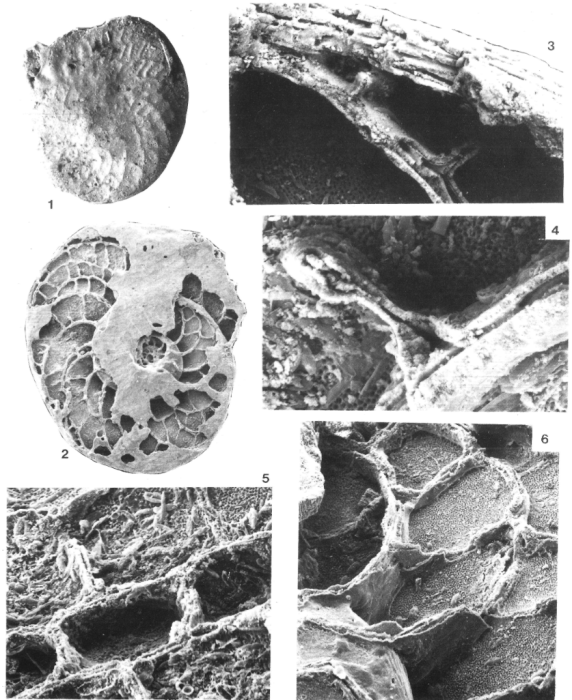
Heterostegina depressa d'Orbigny, 1826 Neotype
Description Banner, F. T.; Hodgkinson, L. R. (1991). A revision of the foraminiferal subfamily Heterostegininae. Revista Española de Micropaleontología. 23(2): 101-140.page(s): p. 110, PI. 2, Figs. 1-6 (Neotype pl. 2 fig. 1)
Fig. 1. Heterostegina (H.) depressa d'Orbigny, neotype here selected, and deposited in the British Museum (Natural History), London, from 15º54.4'south, 5°42.5' west, off Banks Point, Saint Helena Island, south Atlantic Ocean, from 10 fathoms (appr. 183 m), Holocene: x 23 BM(NH) ZF 4827.
Fig. 2. H. (H.) depressa d'Orbigny, topotype (from the same sample as the neotype, fig. 1), dissected to show internal structure, x 28.5; BM(NH) ZF 4832. H. (H.) depressa d'Orbigny; details of the specimen shown in fig. 2.
Figs. 3-6. Fig. 3, x 460, canals of the test periphery (marginal cord) and of the (essentially bilamellar) primary and secondary septa. Fig. 4, x 925; an incomplete secondary septum (showing the forward-folding of the anterior septal lamella), and the diatom-filled chamberlets of the last-formed whorl; the diatoms are too big to have been transported by the canals, but theycould have passed through the pore-like apertures in the septa (compare plate 1, figure 3c). Fig. 5, x 300; diatom-filled chamberlets of the middle of the last-formed half of the last whorl; the frustules are evenly spread between the chamberlets (missing in only one chamberlet), and they are not heaped or clumped into one part only of the chambers. Fig. 6, x 200, empty chamberlets, without residual diatom frustules, in the penultimate whorl, where cover by the ultimate whorl had prevented photosynthetic activity by endosymbionts. PNG file - 874.72 kB - 837 x 1 026 pixels added on 2025-05-0417 viewsWRiMS taxa Heterostegina depressa d'Orbigny, 1826checked Le Coze, François 2025-05-04
This work is licensed under a Creative Commons Attribution-NonCommercial-ShareAlike 4.0 International License
 Comment (0)
Comment (0)